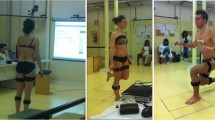Abstract
Background
Classical posturography techniques have been recently enhanced by the use of different motion tracking devices, but for technical reasons they are not used to track directly the body spatial position of a subject.
Objective
To describe and clinically evaluate a wireless inertial measurement unit-based mobile system to track body position changes.
Methods
The developed system used a calculus transformation method using the acceleration data corrected by Kalman and Butterworth filters to output position data. A prospective non-randomized clinical study involving 15 healthy subjects was performed to evaluate the agreement between the confidence ellipse areas synchronously measured by the new developed system and a classical posturography system while performing a modified clinical test of sensory interaction in balance.
Results
The overall intra-class correlation index was 0.93 (CI 0.89, 0.96). Grouped by conditions, under conditions 1–4, Pearson’s correlation was 0.604, 0.78, 0.882, and 0.81, respectively.
Conclusion
The developed wireless inertial measurement unit-based posturography system was valid for tracking the sway variances in normal subjects under habitual clinical testing conditions. Further studies are needed to validate this system on patients and also under other posture conditions.




Similar content being viewed by others
References
Berg K, Norman K (2009) Functional assessment of balance and gait. Clin Geriatr Med 12:705–723
Park Lee (2014) Validity and reliability of balance assessment software using the Nintendo Wii balance board: usability and validation. J NeuroEng Rehabil 11:99
Balaguer-García R, Pitarch-Corresa S, Baydal-Bertomeu J (2012) Static posturography with dynamic tests. Usefulness of biomechanical parameters in assessing vestibular patients. Acta Otorrinolaringol Esp 63:332–338
Rey-Martinez J, Pérez-Fernández N (2016) Open source posturography. Acta Otolaryngol 136(12):1225–1229
Vališ M, Dršata J, Kalfeřt D (2012) Computerised static posturography in neurology. Cent Eur J Med 7:317–322
Black F (2001) What can posturography tell us about vestibular function? Ann N Y Acad Sci 942:446–464
Norré M (1995) Head extension effect in static posturography. Ann Otol Rhinol Laryngol 104:570–573
Brandt T, Dieterich M, Strupp M (2005) Vertigo and dizziness: common complaints. Springer, London
Clark R, Bryant A, Pua Y, McCrory P, Bennell K, Hunt M (2010) Validity and reliability of the Nintendo Wii Balance Board for assessment of standing balance. Gait Posture 31:307–310
Allum J, Adkin A (2003) Improvements in trunk sway observed for stance and gait tasks during recovery from an acute unilateral peripheral vestibular deficit. Audiol Neurootol. 8:286–302
Faraldo-García A, Santos-Pérez S, Labella-Caballero T, Crujeiras R, Soto-Varela A (2013) Age-adjusted normality patterns for posturography by Sway Star system. Eur Arch Otorhinolaryngol 270:3169–3175
Rey-Martínez J, Boleas-Aguirre M, Pérez N (2005) Postural analysis of the test “timed-up-and-go” in patients with vertigo. Acta Otorrinolaringol Esp 56:107–111
Newton I (1687) Philosophiae naturalis principia mathematica: public domain. https://www.gutenberg.org/ebooks/28233
Ostebee A, Zorn P (1997) Calculus from graphical, numerical, and symbolic points of view. Harcourt College Pub, San Diego
Hol MK, Schon TB (2016) Using inertial sensors for position and orientation estimation. Found Trends Signal Process 11(1–2):1–153
Allum J, Zamani F, Adkin A, Ernst A (2002) Differences between trunk sway characteristics on a foam support surface and on the Equitest ankle-sway-referenced support surface. Gait Posture. 16(3):264–270
Tadayon P, Felderhoff T, Knopp A, Staude G (2016) Fusion of inertial and magnetic sensors for 3D position and orientation estimation. Conf Proc IEEE Eng Med Biol Soc 3362–3365
Shumway-Cook A, Horak F (1986) Assessing the influence of sensory interaction of balance. Suggestion from the field. Phys Ther 66:1548–1550
Domènech-Vadillo E (2019) Normative data for static balance testing in healthy individuals using open source computerized posturography. Eur Arch Otorhinolaryngol 276:41–48
Shrout P, Fleiss J (1979) Intraclass correlations: uses in assessing rater reliability. Psychol Bull 86:420–428
Koo T, Li M (2016) A guideline of selecting and reporting intraclass correlation coefficients for reliability research. J Chiropr Med 15:155–163
Bland J, Altman D (1986) Statistical methods for assessing agreement between two methods of clinical measurement. Lancet 8:307–310
Fujimoto C, Kamogashira T, Kinoshita M, Egami N, Sugasawa K, Demura S et al (2014) Power spectral analysis of postural sway during foam posturography in patients with peripheral vestibular dysfunction. Otol Neurotol. 35(10):317–323
Rossi-Izquierdo M, Soto-Varela A, Ernst A, Rubio-Rodríguez J, Santos-Pérez S, Sesar Á et al (2016) What could posturography tell us about balance problems in Parkinson’s disease? Otol Neurotol 37(9):326–331
Faraldo-García A, Soto-Varela A, Santos-Pérez S (2015) Is it possible to shorten examination time in posture control studies? Acta Otorrinolaringol Esp 66(3):154–158
Assessment, A. A. N. (1993) Assessment: posturography. Report of the therapeutics and technology assessment subcommittee of the American Academy of Neurology. Neurology 43(6):1261–1264
Wrisley D, Stephens M, Mosley S (2007) Learning effects of repetitive administrations of the sensory organization test in healthy young adults. Arch Phys Med Rehabil 88:1049–1054
Funding
No funding was received for this research.
Author information
Authors and Affiliations
Corresponding author
Ethics declarations
Conflict of interest
The authors declare no conflict of interest.
Ethical approval
Because not medical device CE mark measurement non-invasive devices were used on humans for this study, local government ethic committee (CEIC-Donostia) was required and obtained for this study.
Statement of human rights
This clinical study was designed and performed in accordance with the ethical guidelines of the 1975 Declaration of Helsinki.
Additional information
Publisher's Note
Springer Nature remains neutral with regard to jurisdictional claims in published maps and institutional affiliations.
Rights and permissions
About this article
Cite this article
Valldeperes, A., Altuna, X., Martinez-Basterra, Z. et al. Wireless inertial measurement unit (IMU)-based posturography. Eur Arch Otorhinolaryngol 276, 3057–3065 (2019). https://doi.org/10.1007/s00405-019-05607-1
Received:
Accepted:
Published:
Issue Date:
DOI: https://doi.org/10.1007/s00405-019-05607-1




